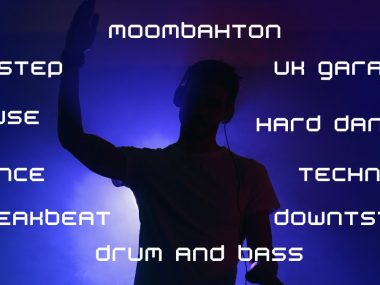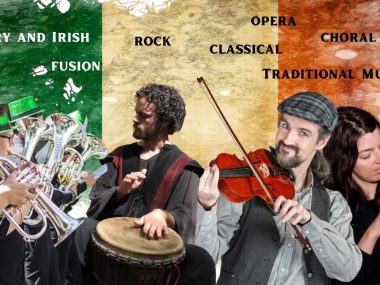Intense guitar riffs, reverberatingly loud instrumentals, and heavy vocals—those are some of the first things that come to mind at the mention of metal music. But with over 15% of music consumers listening to the genre, there’s more to it than distorted noise and intense lyrics.
Ever since its emergence, a wide variety of metal genres have come to fruition. For non-metal fans, they can be quite difficult to distinguish from one another. But in truth, each genre has its own distinct characteristics, vocal style, and song structure.
Believe it or not, there are several dozen subgenres of metal music. So, if you’re interested in the cornucopia of subgenres it has to offer, stick around. This article discusses some of the most common types of metal music.
1. Heavy Metal
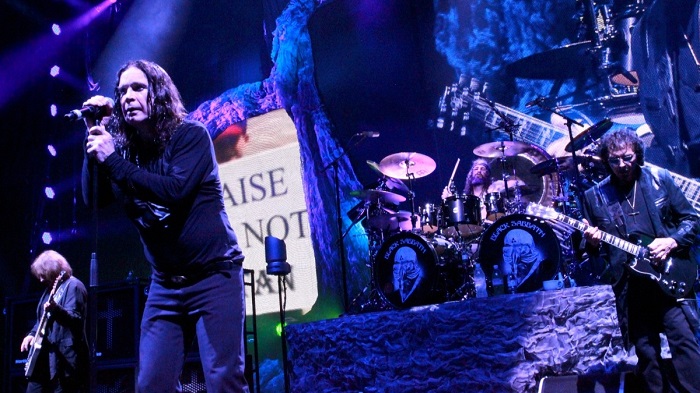
Let’s start this list off with the “father” of all metal subgenres—the original heavy metal music.
Developed in the late 1960s, traditional heavy metal started off as a genre of rock music.
With stylistic origins in psychedelic rock, acid rock, and blues-rock, OG metal bands developed a thundering sound characterized by emphatic beats, extended guitar solos, and a lot of distortion.
For most people, heavy metal comes to mind when discussing metal music.
Thanks to bands like Black Sabbath, Led Zeppelin, and Deep Purple, the genre attracted audiences across the world.
It evolved shortly after, splintered into multiple styles and subgenres to match the music tastes of certain individuals.
2. Funk Metal
As you may have already guessed, funk metal is basically a combination of funk music and heavy metal music. For this reason, funk metal is infused with jazzy, soulful tunes that are rarely heard in other metal genres.
Initially, funk metal started off as a subgenre of alternative metal music. However, unlike other alternative metal genres, funk metal bands often utilized a riffing style similar to 1980s thrash metal.
During the late 90s, funk metal branched out of the alternative metal genre and developed its own unique sound and characteristics. Today, they’re classified as a completely separate genre of metal.
Some of the most popular funk metal bands include Rage Against the Machine, Faith No More, Infectious Grooves, and Primus.
3. Power Metal

Developed in the late 1980s, power metal is characterized by fast, high-pitched vocals and clean, undistorted noise.
Power metal is perhaps the most melodic and easy-flowing subgenre of metal. It’s also much more upbeat and positive than other metal genres, seeking to inspire courage, joy, and empowerment.
The lyrics of power metal songs lean into the fantastical aspects of the world. It’s therefore of no surprise that the songs have an epic, theatrical, and emotionally impactful sound.
Some of the most notable power metal bands include Kamelot, Powerwolf, Rhapsody of Fire, and DragonForce.
4. Black Metal
Black metal is a subgenre of extreme heavy metal. It features highly distorted instrumentals, fast tempos, blast beat drumming, and shrieked vocals.
The “first wave” of black metal artists appeared during the 1980s, thanks to bands like Hellhammer, Celtic Frost, and Venom.
Upon its inception, black metal was met with extreme hostility from the mainstream audience, mainly because of the anti-Christian, iconoclastic, and misanthropic nature of its songs.
Several of black metal’s pioneers have been linked to neo-Nazism, murder, and church burnings, which further fueled public hate towards the genre. Due to this, black metal was dubbed as “Satanic metal” by critics.
With that said, most black metal fans and musicians reject the Nazi ideology and other harmful actions and beliefs that were linked to the genre.
There are several derivatives of black metal music, including:
- NSBM (National Socialist Black Metal)
- RABM (Red and Anarchist Black Metal)
- Blackened heavy metal
- Blackened screamo (AKA blackened skramz)
- Blackgaze
- Symphonic black metal
- Viking metal
- War metal
5. Christian Metal
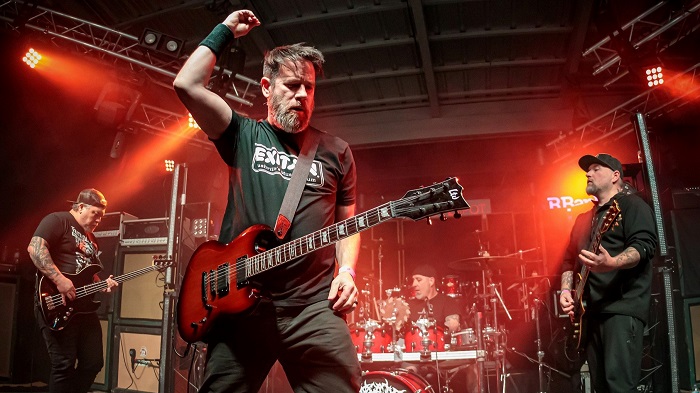
Christian metal, sometimes referred to as white metal, is defined by its Christian-themed song lyrics.
Christian metal is targeted towards Christians who love listening to heavy metal music. The genre is usually performed by Christian musicians and is often distributed through Christian networks.
It first came to be in the late 70s to preach the Christian gospel among heavy metal music fans. It was pioneered by bands such as Sweden’s Jerusalem, Petra, and Resurrection Band. Other bands include Demon Hunter, Living Sacrifice, and August Burns Red.
The only difference between Christian metal and other forms of metal is its lyrics. Therefore, a thrash metal band or a funk metal band can simultaneously be a Christian metal band if it features Christian themes.
Christian metal artists exist in almost all subgenres of metal, making it among the most widespread subgenres of all time.
6. Unblack Metal
Unblack metal is a subgenre of Christian metal.
Stylistically, unblack metal features most if not all of black metal’s music characteristics. However, instead of promoting “taboo” topics such as war, destruction, and misanthropy, unblack metal features themes of spiritual battle, salvation, and worship.
Unblack metal bands include Crimson Moonlight, Horde, Admonish, and Antestor.
7. Crust Punk
Crust punk, or simply crust, is a metal subgenre influenced by hardcore punk, anarcho-punk, and extreme metal.
Developed in the mid-80s in England, crust often features pessimistic lyrics that focus on social and political ills. It’s also defined by its “crusty” or dirty sound, with fast tempos and guttural and/or screamed vocals.
Examples of crust punk bands include Discharge, Disfear, Extreme Noise Terror, and Amebix.
8. Blackened Crust

Blackened crust is a subgenre of crust punk.
As you may have guessed, blackened crust is basically crust that features black metal elements. The term was coined by the band Iskra, who’s also come up with the subgenre.
Gallhammer, a Japanese extreme metal group, has combined elements of crust punk and black metal in their more recent material. The same is said with the Norwegian band Darkthrone, who claims that blackened crust is an ironic paradox of the two genres.
9. Avant-Garde Metal
Also known as avant-metal or experimental metal, avant-garde metal is characterized by its innovative use of avant-garde elements and unconventional, non-standard vocals and instrumentals.
Avant-garde metal evolved out of death metal, extreme metal, progressive rock, and jazz fusion.
Fans of this genre often classify avant-garde metal music as “weird” and “bizarre.”
Sometimes, avant-garde metal songs aren’t songs at all. Some feature long, sustaining drones of fuzz and hums rather than actual vocals and instrumentals.
Examples of Avant-garde metal music include Dog Fashion Disco, Celtic Frost, and Sunn O))).
10. Death Metal
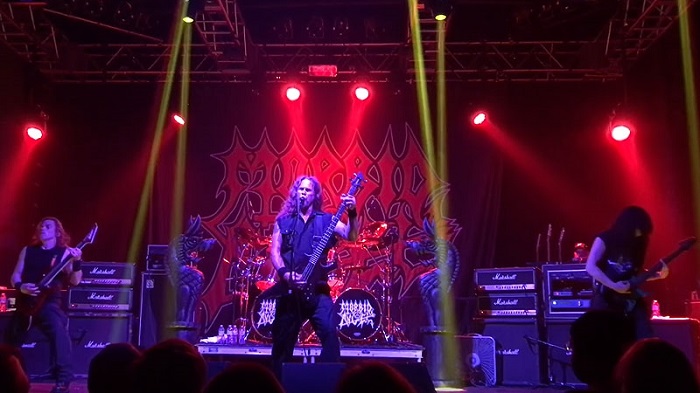
Death metal is perhaps one of the most common genres of heavy metal. It’s characterized by deep growling vocals, thickly distorted guitars, blast beat drumming, alternate picking, multiple tempo changes, and complex song structures.
This heavy metal subgenre appeared during the mid-80s when musicians combined elements of early black metal and thrash metal together.
Many consider Deicide, Carcass, and Morbid Angel as the pioneers of the death metal genre. Notable bands that influenced the subgenre include Kreator, Venom, Slayer, and Celtic Frost.
As death metal reached mainstream audiences, the subgenre was split into more subgenres. Some include:
- Blackened death metal
- Melodic death metal
- Death ‘n’ Roll
- Symphonic death metal
- Technical death metal
11. Doom Metal
Doom metal is one of the more recognizable subgenres of extreme metal music.
Unlike most extreme metal genres, doom metal is characterized by low-tuned guitars, slower tempos, and deeper or “heavier” sounds. It aims to evoke a sense of dread, despair, and impending doom to the listener—thus the name “doom metal.”
Black Sabbath heavily influenced the doom metal genre. Their songs “Into the Void,” “Black Sabbath,” and “Electric Funeral” are considered some of the first doom metal songs ever written and performed.
Thanks to its distinct style, several derivatives of the genre formed over the years. Notable ones include:
- Death/doom
- Sludge metal
- Funeral doom
- Drone metal
- Stoner metal
12. Glam Metal

Glam metal, otherwise known as pop-metal or hair metal, is a fusion between glam rock and heavy metal. It first came to be in the 1970s and was later popularized throughout the 1980s and the early 1990s, primarily due to the influence of MTV.
Like glam rock, glam metal bands often dressed in flamboyant clothing, teased-up hair, and heavy make-up to achieve an androgynous appearance.
Alongside hard-hitting drumming and catchy hooks, glam metal features studio-engineered sound, not unlike New Wave of British Heavy Metal bands. The vocals are soft with “sing-along” choruses and clean hard rock tunes.
Popular glam metal bands include Bon Jovi, Poison, Ratt, and Black Veil Brides.
13. Folk Metal
For non-metal fans, it’s difficult to imagine folk music and metal music as one genre. But it actually works surprisingly well.
Folk metal music is a combination of traditional folk music and heavy metal music. It features traditional folk instruments like violins, flutes, and mandolins, as well as traditional singing styles like Spanish Stone of Erech, Danish Sylvatica, and Dutch Heidevolk.
Lyrics often feature mythological or historical themes to give the song an ancient medieval quality.
Folk metal was developed in the 1990s in Europe. Golgotha’s 1984 EP, “Dangerous Games,” is one of the earliest examples of folk metal music. However, the genre didn’t catch on until Skyland’s 1990 debut album, “The Wayward Songs of Mother Earth.”
Since then, multiple variations of the subgenre emerged, including pagan metal, Celtic metal, and pirate metal.
Some of the most notable folk metal bands include Finntroll, Korpiklaani, Arkona, and Turisas.
14. Industrial Metal
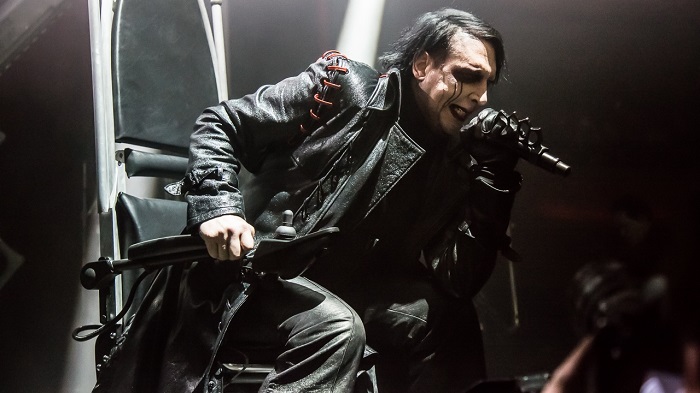
Industrial metal is a fusion between industrial music and heavy metal. It’s characterized by distorted vocals, repetitive guitar riffs, synthesizer lines, and artificial sounds.
The industrial metal genre is divided into two subgenres: industrial death metal and industrial black metal.
Industrial death metal emerged when industrial artists, such as Nailbomb and Meatbook Seed, began adding death metal elements to industrial music.
Industrial black metal is a relatively new subgenre. It was developed in the early years of the 21st century when groups from the black metal scene featured characteristics of industrial music in their songs.
Notable industrial metal acts include Marilyn Manson, Nine Inch Nails, Rammstein, and Fear Factor.
15. Kawaii Metal
As the name implies, kawaii metal, also known as cute metal or idol metal, is a heavy metal subgenre that features Japanese vocals and idol aesthetics. It’s basically a combination of J-pop and metal.
The genre first appeared in the late 2000s, pioneered by Japanese idol bands like Ladybaby, Babymetal, and Dazzle Vision. It uses multiple elements of power metal and industrial metal, and occasionally dips its toes in death metal and post-hardcore.
16. Metalcore
Metalcore is an amalgamation of hardcore punk and heavy metal. It’s characterized by intense guitar solos, blast beat drumming, and harsh, screaming vocals.
Metalcore is distinguished by its half-time breaks and open strings to obtain a low-pitched sound.
Subgenres of metalcore include the following:
- Melodic metalcore
- Electronicore
- Mathcore
- Progressive metalcore
- Deathcore
- Nu metalcore
17. Grindcore
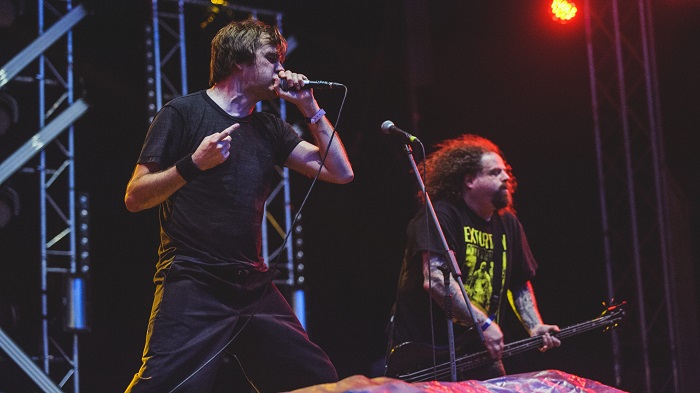
Grindcore is a unique combination of hardcore punk, death metal, and crust punk.
Unsurprisingly, the subgenre is mostly characterized by guttural vocals, hard beats, and lyrics that focus on violence, gore, and sometimes politics.
Grindcore and death metal are often used interchangeably as they share many stylistic components.
However, grindcore is much more chaotic than death metal. Most grindcore songs feature unconventional forms of music and lack traditional time signatures.
The genre was developed in the 80s by the band Napalm Death. Other grindcore bands include Repulsion, Brutal Truth, and Carcass.
Grindcore is split into four major subgenres:
- Deathgrind
- Pornogrind
- Goregrind
- Electrogrind
18. Gothic Metal
Gothic metal is a fusion of gothic rock, doom metal, and darkwave. It features dark, heavy tunes with loud guitars, ethereal synths, and aggressive lyrics.
Gothic metal doesn’t have a specific stylistic sound; it can be slow and crushing or orchestral and overwhelming. Its vocal styles are also quite diverse, ranging from deep guttural growls to intense black metal shrieks.
Early gothic metal bands include Paradise Lost, Within Temptation, Type O Negative, and Theatre of Tragedy.
19. NWOBHM

NWOBHM, also known as New Wave of British Heavy Metal, was coined in the late 70s by British Journalist Geoff Barton. He used the acronym “NWOBHM” to describe the emergence of new heavy metal bands across the UK.
NWOBHM is a fusion between punk rock and heavy metal. However, unlike punk-metal—which is a subgenre of thrash metal—NWOBHM infuses the intensity of punk rock with 1970s heavy metal. This results in aggressive instrumentals, guitar solos, and fast, raw-sounding vocals.
Notable NWOBHM bands include the Iron Maiden, Saxon, and Def Leppard.
20. Thrash Metal
Thrash metal is the earliest form of extreme metal music.
Characterized with complex guitar riffs, fast tempos, and aggressive vocals, thrash metal is intense, electric, and heart-poundingly energetic.
The genre stemmed from various other metal subgenres, including speed metal, hardcore punk, and NWOBHM.
Slayer, Megadeth, Metallica, and Anthrax are considered the “Big Four” of thrash metal. On the other hand, Tankard, Destruction, Sodom, and Kreator are dubbed as the “Big Teutonic Four” of the European region.
Thrash metal has three subcategories, including crossover thrash, Teutonic thrash metal, and groove metal.
Crossover thrash features more hardcore punk elements than thrash. For this reason, it’s often dubbed punk metal.
Teutonic thrash metal is heavily influenced by NWOBHM and thus less “thrashy” than regular thrash. It incorporates muted riffs, raspy vocals, and quick bass drumming.
Finally, groove metal, also known as power groove or neo-thrash, features bluesy solos, slow thrash riffs, harsh vocals, and heavy drum work.
21. Speed Metal

Speed metal originated from NWOBHM and thrash metal. It was heavily influenced by hardcore punk music in the late 70s and early 80s.
As the name implies, speed metal is all about speed. It’s fast, technically demanding, and abrasive.
However, unlike NWOBHM and most thrash music, speed metal rarely employs harsh vocals. It’s slightly more aggressive than traditional heavy metal, but only because it’s paced faster.
Speed metal bands include Motorhead, Anvil, Venom, and Judas Priest.
22. Symphonic Metal
Symphonic metal uses symphonic elements in its songs, usually with electric keyboards that stimulate classical instruments, actual classical instruments, or live orchestras.
Examples of symphonic metal artists include Therion, Nightwish, and Epica.
23. Grunge
Grunge is a subgenre of heavy metal that uses elements of punk rock, alternative rock, noise rock, sludge metal, thrash metal, and several others in its songs.
It often features meaningful and “socially taboo” lyrics with themes of apathy, nihilism, social alienation, abuse, psychological trauma, and neglect.
Like the genres it was influenced by, grunge uses heavily distorted power chords, blues-inspired solos, and gravelly, raspy vocals.
Prominent bands of the genre include Alice in Chains, Pearl Jam, and Nirvana.
24. Latin Metal

Latin metal is a subgenre of metal music with Latin origins, instrumentals, influences, and vocals. It also sometimes uses Latin rhythms and percussion, as well as Latin musical traditions.
The term “Latin metal” was coined by American music journalist Robert Christgau, who dubbed Carlos Santana’s as “Latin-metal pop” in the 1970s.
Examples of Latin metal musicians include Ill Niño, Ankla, Puya, and Angeles del Infierno.
25. Neoclassical Metal
Also known as shred metal, neoclassical metal is influenced by the stylistic composition of classical music.
Unlike symphonic metal, which uses symphonic elements in its songs, neoclassical metal merely borrows classical aspects from classical music. This includes scales, arpeggios, melodies, and instrumentals.
Popular neoclassical metal bands include Symphony X, Cacophony, and Time Requiem.
26. Neue Deutsche Härte (Dance Metal)
Neue Deutsche Härte, directly translated to New German Hardness, is a metal subgenre influenced by alternative metal, groove metal, and the New German Wave. It features elements from techno music, electronic music, and industrial music.
Since Neue Deutsche Härte emerged in Germany, most of the genre’s songs are in German. Songs sung in other genres are dubbed as dance metal.
Like most metal music, NDH utilizes electric guitars, drums, bass, and vocals in its songs. It also uses synthesizers, keyboards, percussion, and samples.
The vocals are over-pronounced, emphasized, and strongly masculine. Female vocalists are rare but not unheard of.
Bands of this subgenre include Rammstein, Oomph!, Stahlmann, and Maerzfeld.
27. Post-Metal

Inspired by post-rock, post-metal came to be in the 1990s through bands such as Godflesh and Neurosis. By incorporating metal elements with experimental compositions found in post-rock, they birthed a subgenre that isn’t limited by the latter’s conventions.
Post-metal uses psychedelic, ambient, progressive, and classical music to create an expansive but atmospheric sound. It also uses long, layered structures that don’t follow the traditional chorus form. Instead, it focuses on repeating themes and crescendos.
The sound of post-metal music primarily features guitars and drums. Vocals are either growled or screamed, almost as if to represent another instrument.
Alongside Godflesh and Neurosis, notable post-metal bands include Cult of Luna, Russian Circles, and Pelican.
28. Progressive Metal
Progressive metal is one of the most complex heavy metal subgenres.
As the name suggests, progressive metal is a combination between progressive rock and heavy metal. However, unlike either of the genres, progressive metal follows unconventional time signatures, complex compositions, and extended but detailed solos.
It also favors rough lyrics, low-pitched riffs, and drawn-out strumming. Vocals are sung melodically if present.
Prevailing themes in progressive metal include government corruption and oppression, existential angst, environmental degradation, and other philosophical and political subject matters.
Dream Theater, Tool, and Queensrÿche are some of the most popular bands of the subgenre. Newer bands include Animals and Leaders, Caligula’s Horse, and Intronaut.
29. Nu-Metal

Nu-metal combines elements of heavy metal with hip-hop, industrial, funk, grunge, and alternative rock music.
It rarely features complex structures and detailed instrumental solos. Instead, it’s more focused on heavily syncopated guitar riffs that are tuned down to achieve a heavier sound.
Unlike other metal genres, nu-metal occasionally star DJs to provide instrumentations like turntable scratching, electronic backgrounds, and sampling. The vocals are a combination of rapping, singing, growling, and screaming.
The subgenre first became popular in the late 90s, when musicians Kid Rock, Korn, and Limp Bizkit released nu-metal albums that were sold by the millions.
Its popularity increased ten-fold in the early 2000s, especially when P.O.D., Papa Roach, and Linkin Park released multi-platinum albums featuring nu-metal songs.
In the 2010s, bands like Of Mice & Men and My Ticket Home revived the genre by reimagining it with subgenres like metalcore and deathcore.
Today, nu-metal is still among the most popular metal subgenres in the world, with newer artists like Poppy, Grimes, and Rina Sawayama integrating the sound into their electronic songs.


